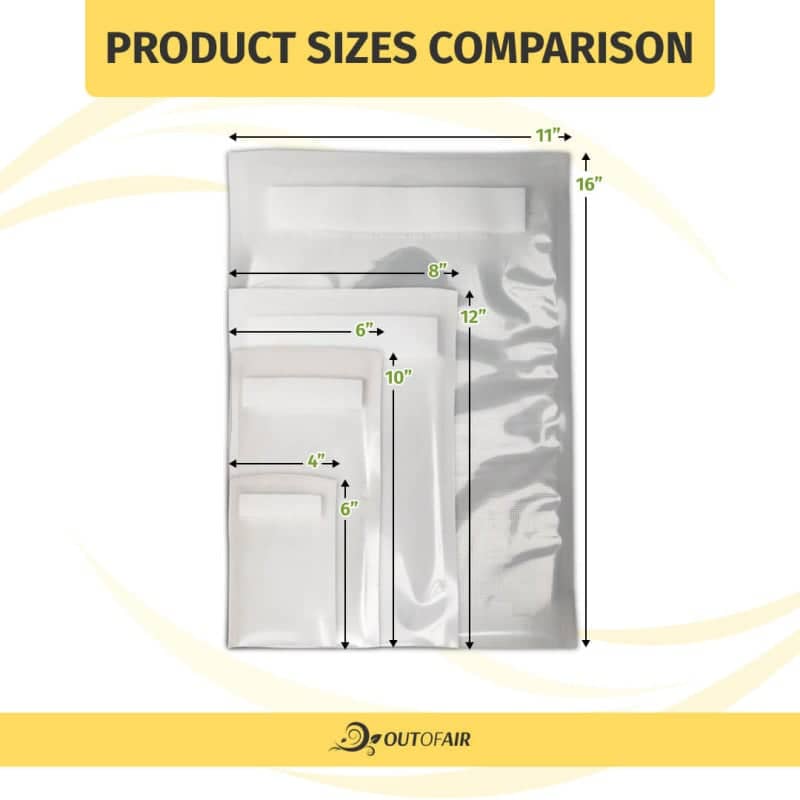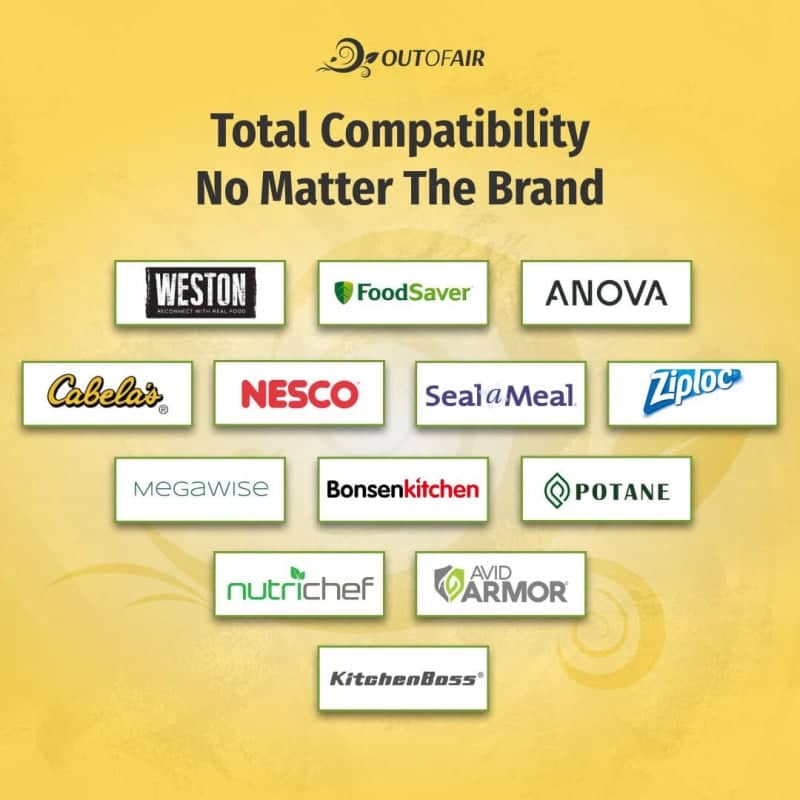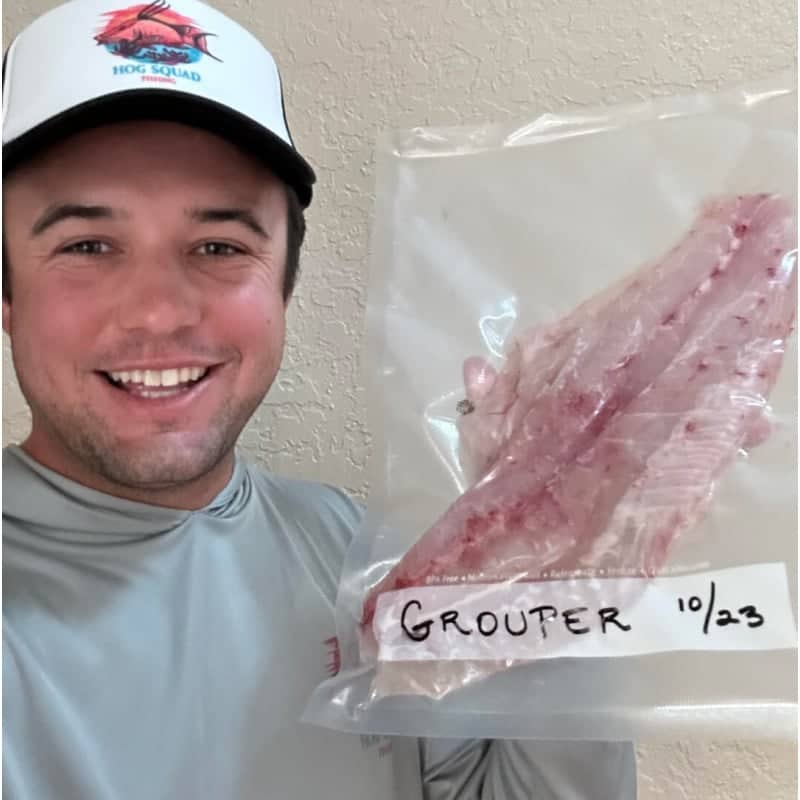The thing about generic vacuum sealer bags is that they're a tad bit difficult to seal.
Quite frustrating if you ask me.
Given the multiple attempts it might take to seal off the bags, it's likely you end up wasting more than what you actually use.
That's why it's important to choose a brand that's both top-quality and cost-effective.
In this post, I get to show you why OutOfAir vacuum sealer bags are an effective alternative to FoodSaver bags.
So what's the difference and what makes them the more suitable option?
Let's find out..
What Are Vacuum Seal Bags?
Vacuum seal bags are specially designed containers used with vacuum machines to vacuum seal food and other items.
They're great for commercial and residential use such as for food preservation, backpacking and camping, and, travel and transportation.
Now let's go to how OutOfAir Bags compare with FoodSaver Bags in terms of pricing..
OutOfAir vs. FoodSaver Bags: Price Comparison
|
Sizes & counts (assuming you want 3 different bag sizes in 100 counts each). |
OutOfAir |
FoodSaver |
|
$16.99 |
$34.57 |
|
|
$20.99 |
$36.66 |
|
|
$31.99 |
$92.16 |
|
|
Total: |
$69.97 |
$163.39 |
(Pricing information was taken from the FoodSaver store on Amazon as of July 30, 2022.)
We believe that vacuum sealer bags don't have to hurt your wallet.
In fact, they exist to save you money - not overspend it.
From the get-go you can see, OutOfAir bags, are up to twice as affordable as FoodSaver bags.
And the best part is, it's not just money that you get to save when you buy affordable vacuum-seal bags.
You're able to free up more of your time and energy too!
How, you ask?
Well to name a few, we have..
- being able to budget and save money on grocery bills by bulk buying during sale promotions and vacuum sealing the larger portions you'll not use for the time being,
- saving time on meal prep by simply reheating pre-packed vacuum-sealed foods, and
- saving energy from cleaning up a messy kitchen after a long day at work!
Doubtful of what I'm saying?
Here’s what a customer, Donna L, has to say about OutOfAir bags:
“The bags are far better than the FoodSaver bags! After I bought the first 100, I bought 200 more. I won't buy any other bags in the future. The shipping was very quick as well. Received within a day or two. Very satisfied!”
OutOfAir is a Verified Merchant. See our trust ratings!
What Do the Different Bag Thicknesses Mean?
Vacuum seal bags have two sides: the glossy side and the embossed one.
Bag thickness is vital in ensuring food safety since it prevents punctures and inconsistencies in the sealing process.
Let's examine how OutOfAir bags differ from FoodSaver bags in terms of thickness:
ⓘ We've taken the information about the layers' number and the thickness of FoodSaver®, GameSaver® and GameSaver® Heavy Duty bags from the FoodSaver.com website, as found on June 1, 2018.
4 mil for vacuum sealing bags is the "just right" thickness to ensure that your bag is tough enough not to be punctured but thin enough at the right section to secure a good seal.
Thinner bags are easily burnt through, while thicker ones at the seal have a tendency to cause problems as it requires more heat to close off properly.
Another point for the right balance in thickness for OutOfAir bags.
Why Should Vacuum Seal Bags Be Malleable?
Having a vacuum-sealing bag that's malleable ensures that your food is securely packed by, primarily, being able to draw all the oxygen out from the bag.
If your vacuum sealer bags are too stiff, it can cause problems when trying to vacuum and seal your food.
A container's malleability is dependent not only on thickness but also on its composition.
OutOfAir bags are highly malleable while highly puncture-resistant.
They're durable and flexible and have been proven to hold longer seals compared to other brands.
Features Overview of OutOfAir and FoodSaver Bags:
Here's a quick rundown of the features of OutOfAir Bags versus FoodSaver Bags.
Features | OutOfAir | FoodSaver |
Material | Polyethylene and nylon | Polyethylene and nylon |
Number of layers | 7 layers | 5 layers |
BPA-free & FDA-approved | Yes | Yes |
Reusable | Yes | Yes |
Microwavable | Yes | Yes |
Freezer safe | Yes | Yes |
Boilable | Yes | Yes |
Write-ready labels | Yes | No |
Tear notches | Yes | No |
Side markings | Yes | No |
FoodSaver's features are based on data obtained from the FoodSaver.com website on July 30, 2022.
Here’s what another satisfied customer, Kim W, said about OutOfAir bags:
“They seem to be better quality than the FoodSaver® brand... lately the rolls I have gotten from them (FoodSaver) have been covered in creases causing massive amounts of sealing failures. The plastic is not too stiff, like some of the other manufactured rolls.”
Read more about OutOfFair reviews.
Can I Boil Vacuum Sealer Bags?
Yes, you can!
OutOfAir bags are made of non-toxic FDA-approved food-safe plastic.
They do not contain Bisphenol-A (BPA) or phthalates.
In addition, they have passed boiling tests up to 100 °C for 4 hours, making them suitable for sous vide cooking. Read more on our FAQ page.
OutOfAir bags can be microwaved, boiled, frozen, and are even reusable - they're dishwasher safe! While FoodSaver bags can only withstand temperatures of 90 °C and may soften or melt if exposed to temperatures above it.
OutOfAir vs. FoodSaver Bags: Final Thoughts
There are several reasons why OutOfAir bags are considered the best alternative to FoodSaver bags.
OutofAir Bags has held its own quite well in terms of affordability, features, thickness, composition, and functionality.
Switching to OutOfAir vacuum seal bags would be an excellent investment for those who wish to save money, time, and energy - but don't just take it from me.
Find out for yourself now and check them out here!
 Vacuum Sealer Bags & Rolls for Food Savers (Free Shipping)
Vacuum Sealer Bags & Rolls for Food Savers (Free Shipping)












































Share this article: